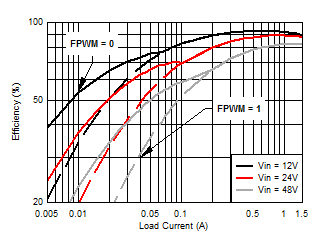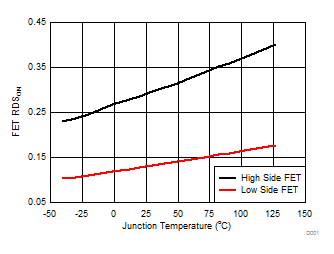SNVSA03E October 2014 – October 2018 LM5160 , LM5160A
PRODUCTION DATA.
- 1 Features
- 2 Applications
- 3 Description
- 4 Revision History
- 5 Pin Configuration and Functions
- 6 Specifications
- 7 Detailed Description
-
8 Application and Implementation
- 8.1 Application Information
- 8.2
Typical Applications
- 8.2.1
LM5160 Synchronous Buck (10-V to 60-V Input, 5-V Output, 1.5-A Load)
- 8.2.1.1 Design Requirements
- 8.2.1.2
Detailed Design Procedure
- 8.2.1.2.1 Custom Design With WEBENCH® Tools
- 8.2.1.2.2 Feedback Resistor Divider - RFB1, RFB2
- 8.2.1.2.3 Switching Frequency - RON
- 8.2.1.2.4 Inductor - L
- 8.2.1.2.5 Output Capacitor - COUT
- 8.2.1.2.6 Series Ripple Resistor - RESR
- 8.2.1.2.7 VCC and Bootstrap Capacitors - CVCC, CBST
- 8.2.1.2.8 Input Capacitor - CIN
- 8.2.1.2.9 Soft-Start Capacitor - CSS
- 8.2.1.2.10 EN/UVLO Resistors - RUV1, RUV2
- 8.2.1.3 Application Curves
- 8.2.2 LM5160 Isolated Fly-Buck (18-V to 32-V Input, 12-V, 4.5-W Isolated Output)
- 8.2.3 LM5160A Isolated Fly-Buck (18-V to 32-V Input, 12-V, 4.5-W Isolated Output)
- 8.2.1
LM5160 Synchronous Buck (10-V to 60-V Input, 5-V Output, 1.5-A Load)
- 8.3 Do's and Don'ts
- 9 Power Supply Recommendations
- 10Layout
- 11Device and Documentation Support
- 12Mechanical, Packaging, and Orderable Information
Package Options
Mechanical Data (Package|Pins)
- DNT|12
Thermal pad, mechanical data (Package|Pins)
Orderable Information
6.7 Typical Characteristics
TA = 25°C and applicable to both LM5160 and LM5160A, unless otherwise noted. Please refer to Typical Applications for circuit designs.
| VOUT = 10 V | RON = 200 kΩ | |
| L = 47 µH |

| VOUT = 5 V | RON = 169 kΩ | |
| L = 47 µH |



| VOUT = 5 V | ||

| VIN = 24 V | ||

| VIN = 24 V | ||

| VIN = 24 V | ||

| VIN = 24 V | ||

| VOUT = 5 V | RON = 215 kΩ | |
| L = 100 µH |

| VOUT = 5 V | RON = 169 kΩ | |
| L = 47 µH |

| VIN = 24 V | ||

| VOUT = 5 V | ||

| VFB = 3 V | ||

| VIN = 24 V | ||

| VIN = 24 V | ||

| VIN = 24 V | ||

| ISW = 200 mA | VIN = 24 V | |